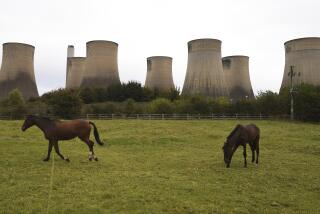Industry Already on Ropes Feels Heat from Chernobyl
- Share via
LONDON — The molten ruin in the West Ukraine will eventually cool but the political fallout from the Chernobyl nuclear plant accident will settle all over the world far into the future.
Indeed, the explosion that blew the top off a Soviet reactor may have severed once and for all the lifeline linking nuclear power to its essential mentors, not only in the Soviet Union but everywhere.
Within the Soviet Union the impact of the accident has been devastating--both on people and on the Soviet system. The Soviet authorities have already shut down all 20 operational plants similar in design to the one that exploded at Chernobyl.
Losing so much electrical supply, possibly indefinitely, will cripple the Soviet economy. Soviet plans for dramatic expansion of nuclear capacity, central to the country’s energy program, must now be profoundly in doubt. But such doubts also extend far beyond Soviet borders.
Here, for instance, the government of Prime Minister Margaret Thatcher is committed to ending Britain’s long hiatus in nuclear power by building a pressurized-water nuclear plant at a site called Sizewell B northeast of London. This reactor, the first of its type in Britain, would be followed in short order by up to five more similar plants, based on the American Westinghouse design.
Since its inception in 1979, the plan has faced stubborn opposition. During an inquiry lasting more than two years, opponents challenged both the economics and the safety of Sizewell B; by last month all three opposition parties had come out against it. But the ruling Conservatives have remained firmly in favor.
In the aftermath of Chernobyl, Thatcher and her Conservative colleagues are insisting that nothing has changed, that Sizewell B must be built and other nuclear plants must proceed. But a Gallup poll published on Sunday indicated that fully three-fourths of Britain’s electorate are now hostile to any expansion of nuclear power in the country. Sizewell B was always going to figure in the forthcoming general election; after Chernobyl, election issues may encompass the entire future of nuclear power in Britain.
Elsewhere in Europe, governments have already conceded that Chernobyl has wrought a fundamental change in policy. In Sweden, moves had been under way to overturn a 1980 referendum that decreed a moratorium on the construction of new nuclear plants and ordered existing ones shut down by 2010.
After Chernobyl, the Swedish government confirmed emphatically that the moratorium still stands. Neighboring Denmark had previously voted not to introduce nuclear power; the Chernobyl accident reinforced the Danish demand that Sweden close its Barseback nuclear plants directly across the straight from the Danish capital of Copenhagen.
In the Netherlands, despite a two-year “national debate” that came out overwhelmingly against any more nuclear power, the government earlier this year announced plans for at least two new plants. Those plans have now been shelved. In Austria those campaigning to bypass the 1978 moratorium against start up of the Tullnerfeld nuclear plant can now have little hope of success.
Finland, the only Western country operating Soviet-built power reactors, had been considering ordering a further unit. The proposal has been scrapped. Indications are that Comecon clients of the Soviet Union may also be having second thoughts about Soviet nuclear technology, as may Cuba with two Soviet reactors due in service by 1990.
Fearing public reaction to Chernobyl, Western nuclear power proponents have insisted vociferously that the Chernobyl reactors were so different in design that the accident could not possibly have happened in the West.
The argument does not carry conviction. The hydrogen explosion that shattered Unit No. 4 at Chernobyl was only a larger version of the hydrogen explosion inside Unit 2 at Three Mile Island in March, 1979. If the bubble that formed inside the TMI unit the following day had exploded, the consequences might have been fully as drastic as those of Chernobyl.
The world’s nuclear industry has yet to achieve maturity as a coherent essential constituent of modern industrial society. Throughout its brief history it has depended on unstinting government support for research and development, safety standards and regulation, uranium enrichment, management of nuclear wastes and even insurance.
Those corporations and financial institutions backing nuclear technology have all too little to show for their efforts. After the Chernobyl disaster they may at last decide to cut their losses and abandon nuclear power.
In that event nuclear power will end as it began. Despite their disillusion, governments that fostered it will have to attend its demise. But it will not simply vanish. Nuclear installations and materials have long been strewn across the face of the Earth, demanding stringent stewardship for generations. Nuclear power will leave a grim legacy--the radioactive detritus of a global misadventure.
More to Read
Sign up for Essential California
The most important California stories and recommendations in your inbox every morning.
You may occasionally receive promotional content from the Los Angeles Times.













